Pompeii
Casts. Vittime da 50 a 53 trovate nel 1974 nella Casa del Bracciale d'Oro, VI.17.42.
Victims 50 to 53 found in 1974 in the House of the Golden Bracelet, VI.17.42.

VI.17.42 Pompeii. Victims 50 to 53. April 2019.
Plaster-casts of a suggested family group of four. On display in Antiquarium. Photo courtesy of Rick Bauer.
According to Lazer et al, these victims were discovered in 1974 at the foot of the staircase leading to the garden and seafront in the so-called House of the Golden Bracelet (VI.17.42).
The group was interpreted as a family because the four victims were found in close proximity to each other.
They comprise two adults and two children.
Cast Number 50 has been interpreted as a male purely on the basis of visual inspection and Cast Number 52 as female simply because there is a child (Cast Number 51) on their lap and they sported a heavy gold bracelet on one arm.
It has been suggested that Cast Number 53 may have been cast in 1978, after the other three victims.
Much more detail can be observed on this cast, and it appears to be much more realistic than the other three in this group.
This group is currently being subjected to a DNA investigation, which is yielding results that do not support the earlier interpretations.
The preliminary results indicate that all the victims in this group are unrelated males.
See Lazer E., et al. 2020. Inside the Casts of the Pompeian Victims: Results from the First Season of the Pompeii Cast Project In 2015. Papers of the British School at Rome.

VI.17.42
Pompeii. Victims 50 to 53. 2018 or 2019.
Plaster-casts
of a suggested family group of four. On display in Antiquarium. Photo courtesy of Giuseppe Ciaramella.

VI.17.42 Pompeii. Victims 50 to 53, May 2018.
Plaster casts of fugitives found in the lower corridor, see VI.17.42, Lower and Garden, for area. Photo courtesy of Buzz Ferebee.
Experts had previously made assumptions about the victims' identities and relationships, but new DNA evidence counteracts their long-held theories.
Inside the House of the Golden Bracelet, three people were discovered at the foot of the staircase - the location gets its name from the jewellery one of the two adults was wearing. This, in addition to the adult being found with a child on their hip, caused experts to believe this victim was a mother of two and the father was the second adult.
But this isn't the case, according to scientists in Italy, Germany and the US as written in the Current Biology journal 2024, as the victim sporting the bracelet was actually found to be a dark-haired, dark-skinned male and he has no relation to the two infant boys found with him, while genetic evidence also appears to point to the second adult also being a male too.
Meanwhile, all three had various eastern Mediterranean or North African origins.
Andrew Wallace-Hadrill, a professor at the University of Cambridge who wasn't involved in study noted how this new DNA evidence "turns some older interpretations, especially those based on rather romantic assumptions, on their head".
He also commented on how this evidence reflects the society at the time.
"One would predict, in a society heavily based on slavery, a significant diversity."
“It is very interesting for instance they have identified an individual with dark skin and black hair, which strongly points to an enslaved person from Africa.”

VI.17.42 Pompeii. Victims 51, 52 and 50 on display in the pyramid in the amphitheatre, September 2015. Plaster-casts of three of the group.


VI.17.42 Pompeii. Boscoreale Antiquarium 2011.
Group consisting of a man (victim 50) and a man (52), who was holding a child (51).
Part of a group of four who died under the staircase. Photo courtesy of Michael Binns.

VI.17.42, Pompeii, May 2018.
Archive photo of the finding of some of the fugitives also showing the golden bracelet. Photo courtesy of Buzz Ferebee.

VI.17.42 Pompeii. Golden bracelet found on the arm of a woman.
According to Barbara McManus, this remarkable bracelet, 610 grams (21.5 oz) of solid gold, is fashioned in the form of two snakes flanking a round disk with a carved relief of Selene with crescent moon and stars above her head.
It was found on the arm of a woman carrying a casket containing 40 aurei and 180 denarii.
She was killed along with another adult and a child when a balcony collapsed in the house.
Photo courtesy of Barbara McManus. See The VRoma Project
Now in Naples Archaeological Museum. Inventory number 14268.
According to recent DNA analysis in 2024, the victim sporting the bracelet was actually found to be a dark-haired, dark-skinned male and he has no relation to the two infant boys found with him.
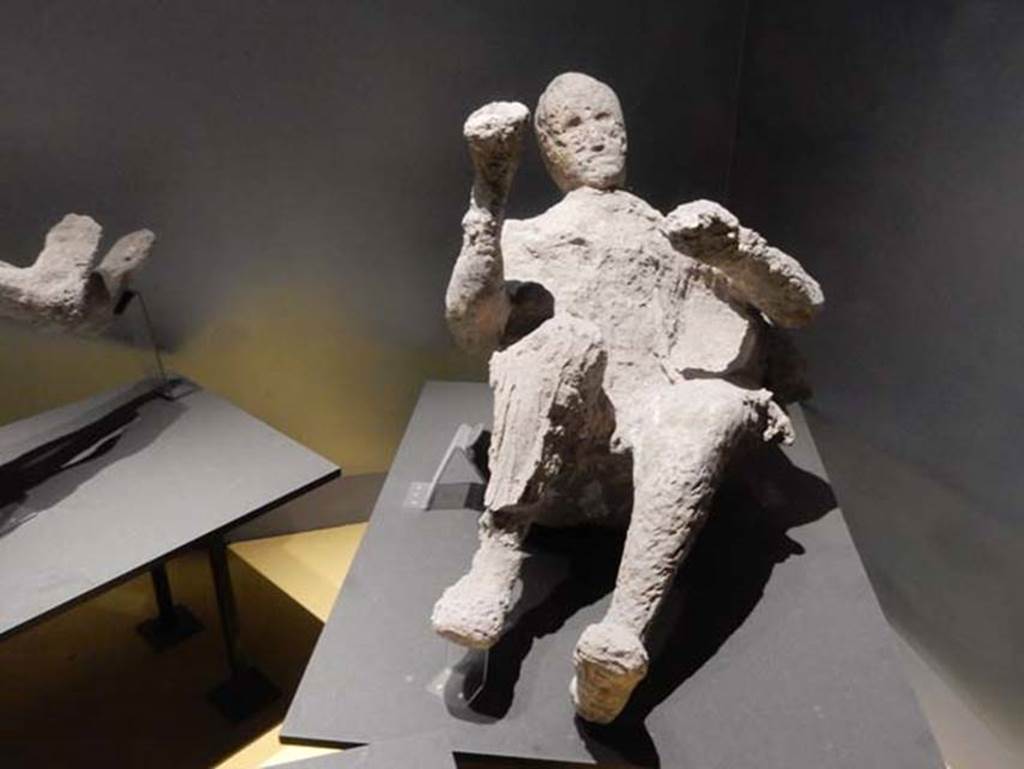
VI.17.42, Pompeii. Victim 50. May 2018.
Plaster cast of man found in the corridor leading to the garden area. Photo courtesy of Buzz Ferebee.
According to Estelle Lazer, it is not possible to make a reliable attribution of sex to this individual from two features of the skull. The orbital margin and supraorbital ridge did not provide consistent information about the sex of this person. The only available feature for estimating age-at-death was the dentition, which suggests a younger adult.
See Lazer E., et al. 2020. Inside the Casts of the Pompeian Victims: Results from the First Season of the Pompeii Cast Project In 2015. Papers of the British School at Rome.
Victim 50 is a male aged over 20 years old.
Imprints of a draped robe are visible on the abdomen, arms and legs.
The body was
found under staircase 30 of the Casa dell Bracciale d’Oro
between the 3rd and 6th of June 1974.
See Osanna, N.,
Capurso, A., e Masseroli, S. M., 2021. I Calchi di Pompei da Giuseppe
Fiorelli ad oggi: Studi e Ricerche del PAP 46, p. 436-8, Calco n. 50.
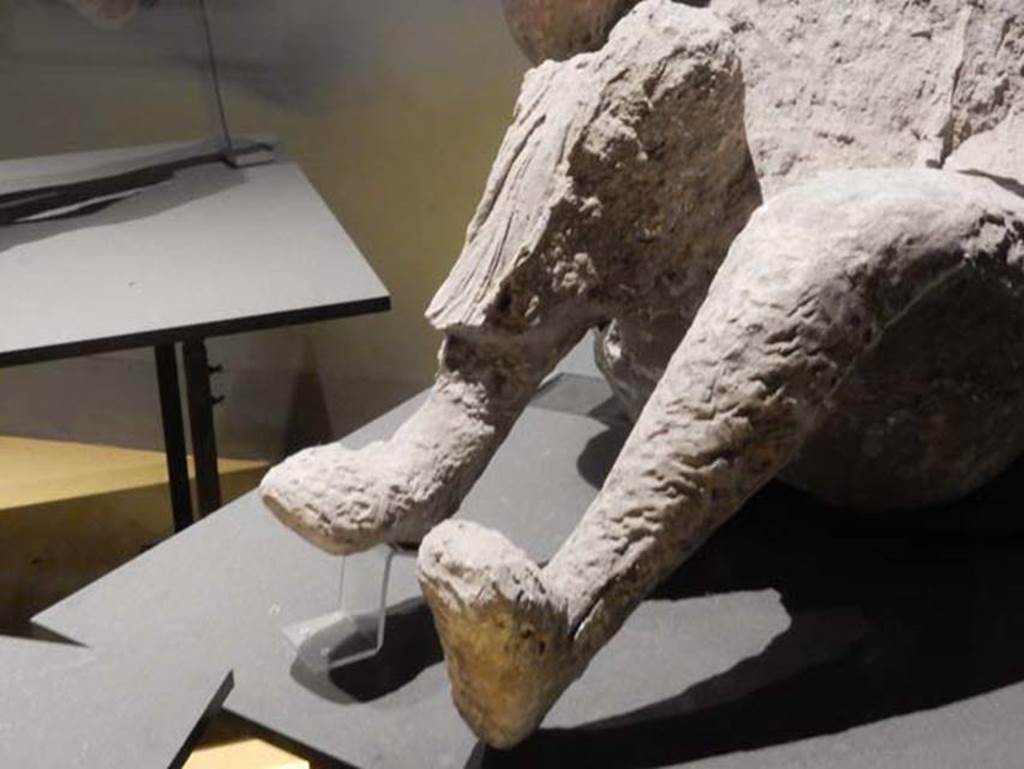
VI.17.42, Pompeii, May 2018.
Plaster cast of legs and feet of man found in the corridor leading to the garden area. Photo courtesy of Buzz Ferebee.
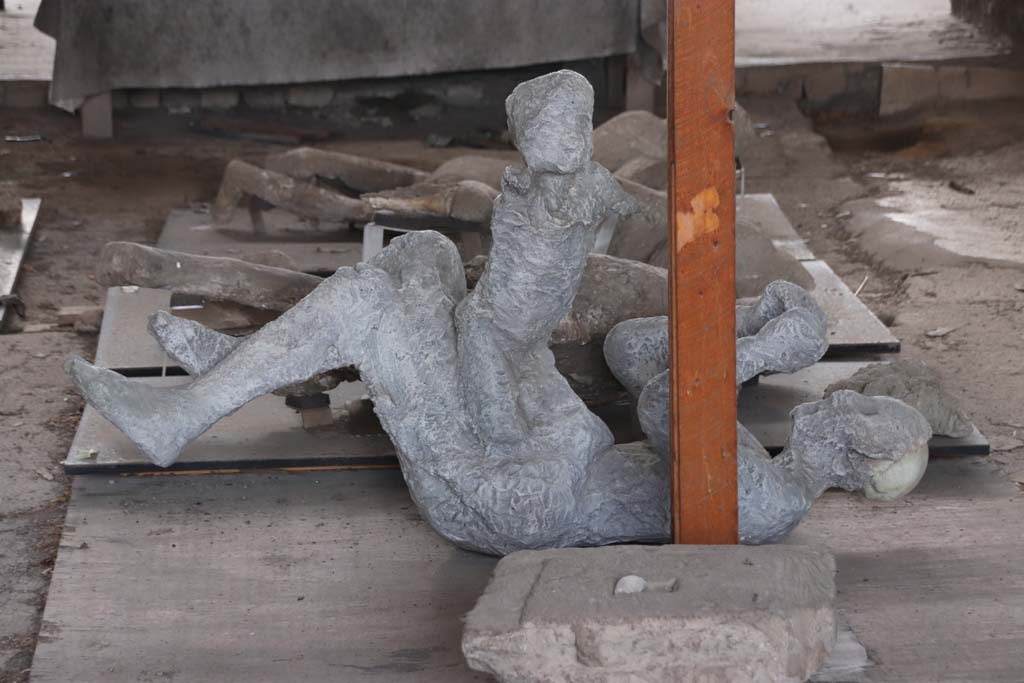
VI.17.42, Pompeii, October 2020.
Plaster cast of a
man (victim 52) and child (51) found in the corridor leading to the garden
area. Photo courtesy of Klaus Heese.
According to Estelle Lazer, it is extremely difficult to determine sex of this child from skeletal evidence.
The mixed dentition observed in the mandible indicates an age-at-death of at least five to six years, depending on the sex of the individual.
There is extensive reconstruction of the lower torso which indicates that more research is required to understand how this cast was achieved.
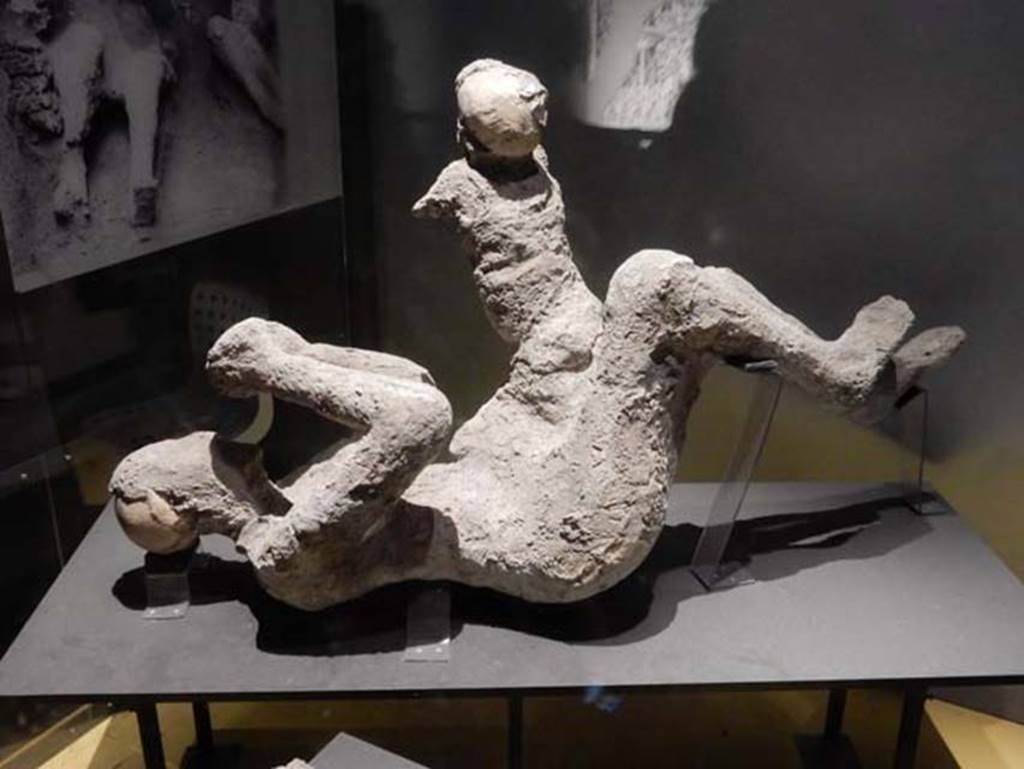
VI.17.42, Pompeii, May 2018.
Plaster cast of a man (52) and child (51) found in the corridor leading to the garden area. Photo courtesy of Buzz Ferebee.
According to Estelle Lazer, this individual (52) is clearly a mature adult, but there is insufficient evidence to make an attribution of the sex of this victim.
See Lazer E., et al. 2020. Inside the Casts of the Pompeian Victims: Results from the First Season of the Pompeii Cast Project In 2015. Papers of the British School at Rome.
Victim 51 is a male child aged less than 6 years, probably 5 to 6 years old.
The body was
found under staircase 30 of the Casa dell Bracciale d’Oro
between the 3rd and 6th of June 1974.
Imprints from a tunic are vaguely identifiable on the chest, shoulders,
back and legs of the victim.
See Osanna, N.,
Capurso, A., e Masseroli, S. M., 2021. I Calchi di Pompei da Giuseppe
Fiorelli ad oggi: Studi e Ricerche del PAP 46, p. 439-440, Calco n. 51.
Victim 52, previously identified as female, is now identified as a male aged not less than 20 years old.
The body was
found under staircase 30 of the Casa dell Bracciale d’Oro
between the 3rd and 6th of June 1974.
Imprints from the clothing are vaguely identifiable on the torso and legs.
See Osanna, N.,
Capurso, A., e Masseroli, S. M., 2021. I Calchi di Pompei da Giuseppe
Fiorelli ad oggi: Studi e Ricerche del PAP 46, p. 441-443, Calco n. 52.
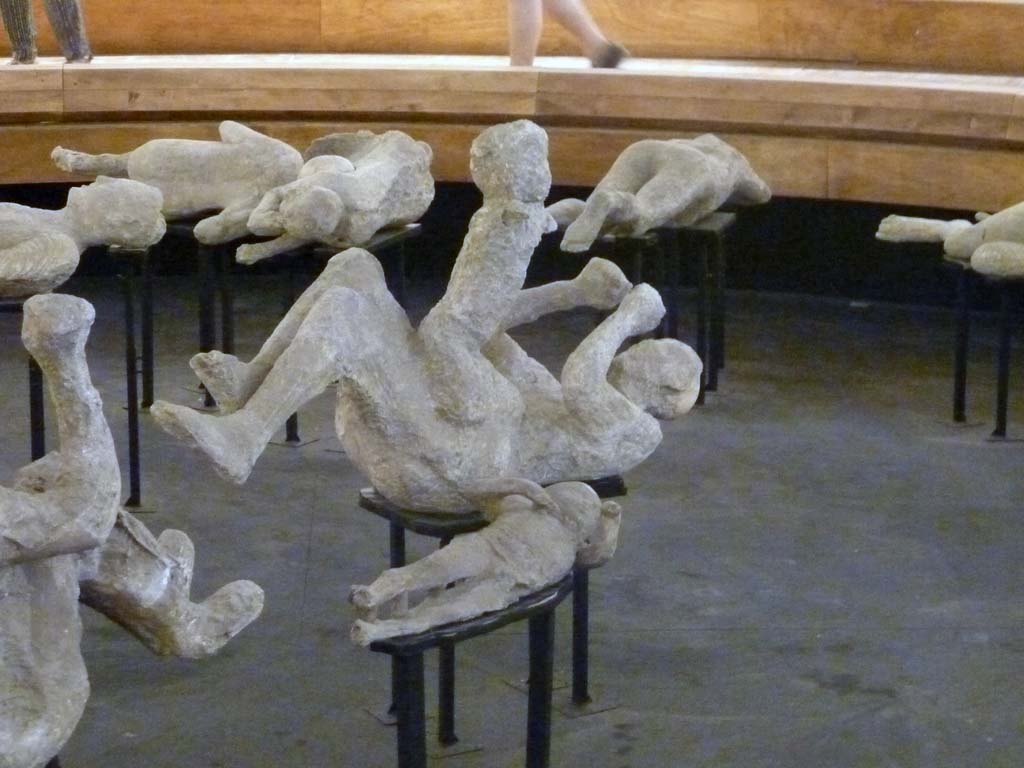
VI.17.42
Pompeii. Victims 51, 52 and 53 on display in the pyramid in the amphitheatre,
September 2015.
Plaster-casts previously
believed to be a mother and two children in the family group of four.
The group of four is now identified as four males.

VI.17.42, Pompeii, May 2018.
Plaster cast of a child (victim 51), on left, and man (victim 50), on right, found in the corridor leading to the garden area.
Photo courtesy of Buzz Ferebee.

VI.17.42, Pompeii. Victim 51. May 2018.
Detail of head of child, found in the corridor leading to the garden area. Photo courtesy of Buzz Ferebee.
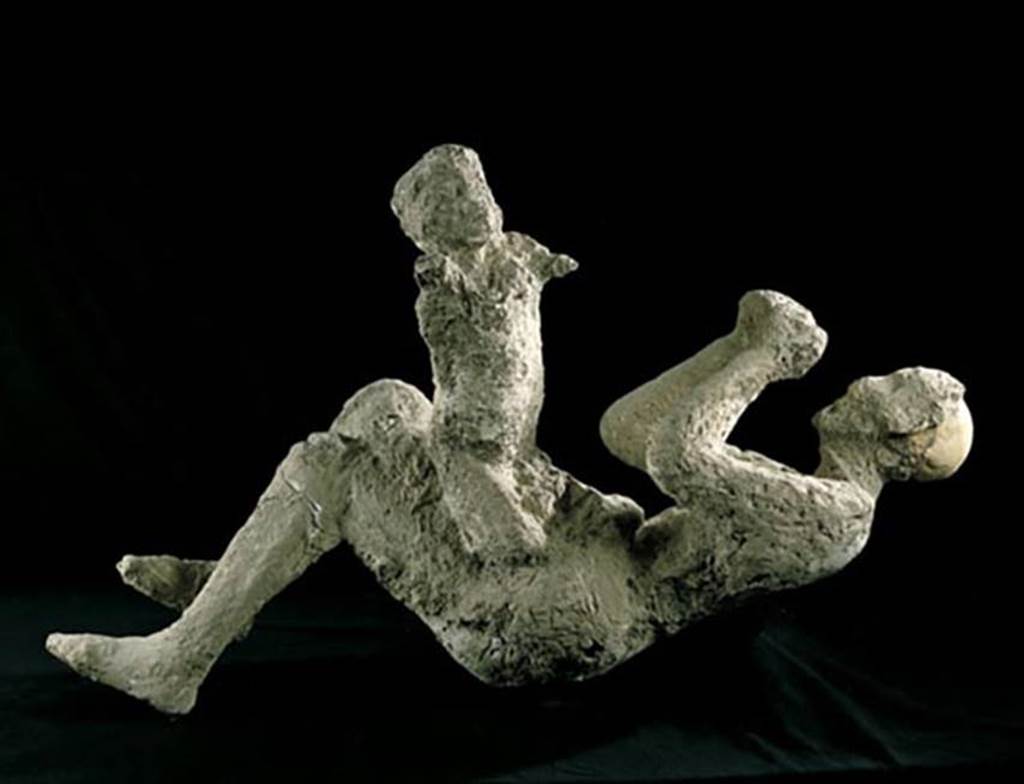
VI.17.42 Pompeii. 1974, cast identified as a woman and child, part of a group of four who died under the staircase.
The group consisted of a man and a woman, who was holding a child, and a few metres away was an older child.
A golden bracelet of exceptional weight and unusual design was found on the arm of the woman.
This gave the name to the house.
All four members of the group have now been identified as male.
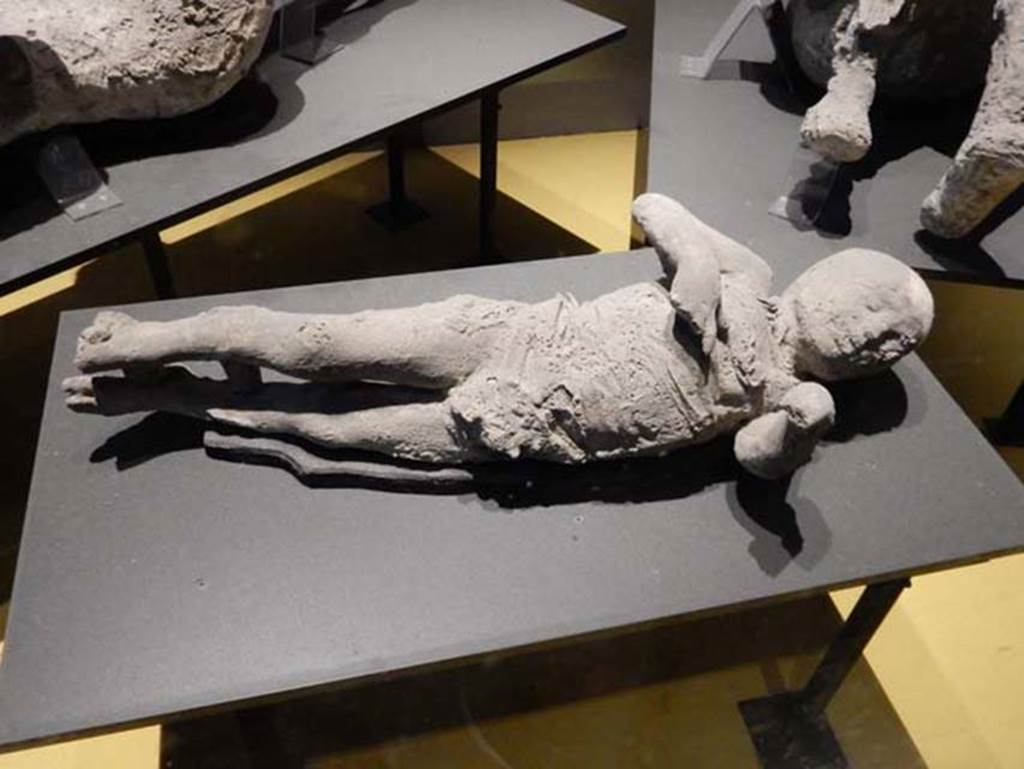
VI.17.42, Pompeii. Victim 53. May 2018.
Plaster cast of young child found in the corridor leading to the garden area. Photo courtesy of Buzz Ferebee.
According to Estelle Lazer et al, "The bone development of the skull suggests an age between one and three years and less than five.
The likely age at death would be between two and three and a half years, with the evidence indicating an age closer to three years.
The overall evidence suggests an age consistent with about three years in a modern Western individual.
At present there is insufficient evidence to make an unequivocal attribution of sex of this individual from gross inspection of the skeletal evidence.
The DNA evidence does suggest that this individual was a male.".
See Lazer E., et al. 2020. Inside the Casts of the Pompeian Victims: Results from the First Season of the Pompeii Cast Project In 2015. Papers of the British School at Rome.
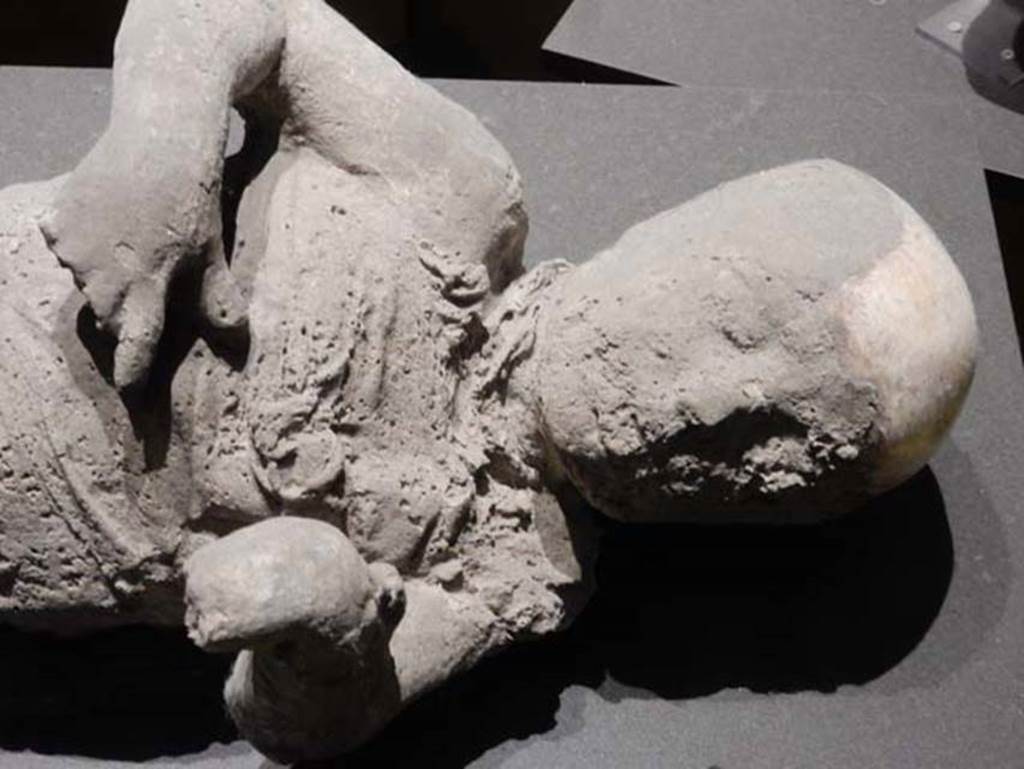
VI.17.42, Pompeii. Victim 53. May 2018. Detail of plaster cast of a young child. Photo courtesy of Buzz Ferebee.
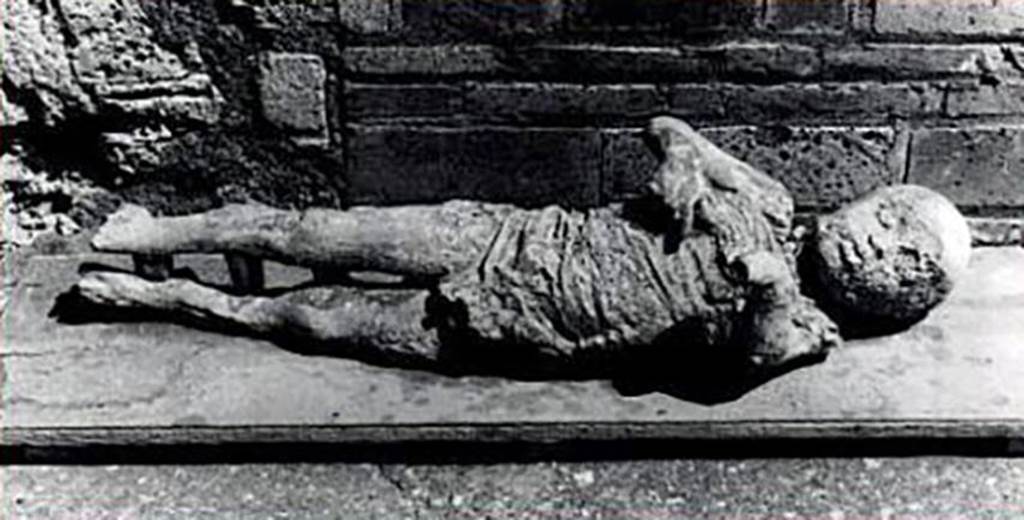
VI.17.42 Pompeii. Victim 53. 1978, cast of a child found in a corridor a few metres from the three other bodies.
Part of a group of four victims who died under the staircase.
Victim 51 is now identified as a male aged less than 6 and probably around 3 years old.
The body was
found in corridor 10 of the Casa dell Bracciale d’Oro
between January and July 1978.
Imprints of a short, sleeveless tunic, perhaps made of linen, are clearly
visible on the torso.
See Osanna, N.,
Capurso, A., e Masseroli, S. M., 2021. I Calchi di Pompei da Giuseppe
Fiorelli ad oggi: Studi e Ricerche del PAP 46, p. 444-5, Calco n. 53.
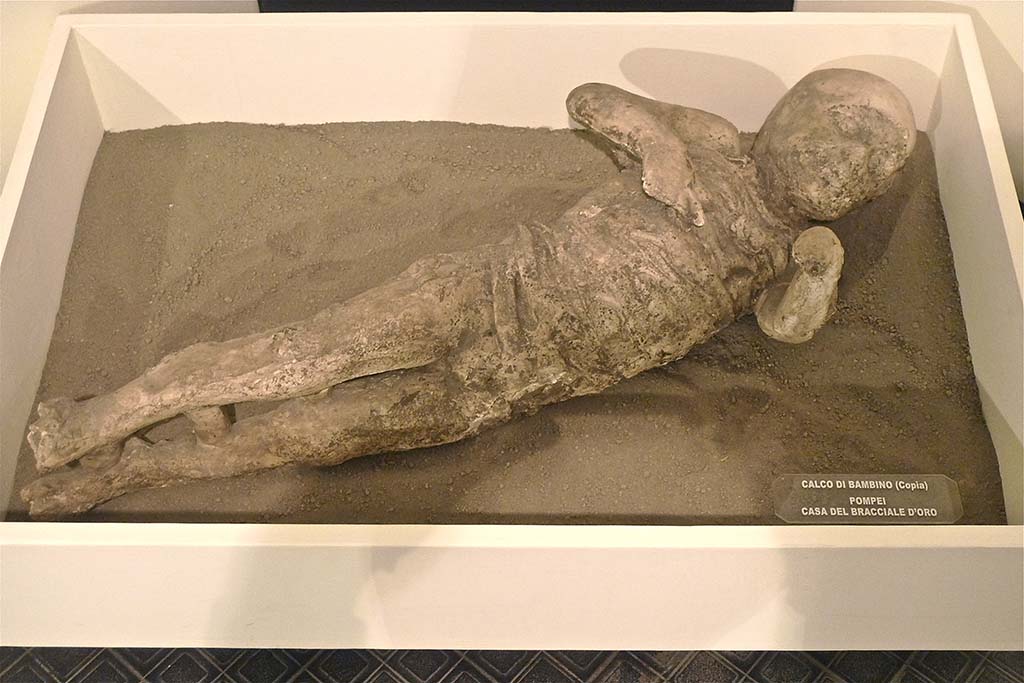
VI.17.42 Pompeii.
Victim 53. Boscoreale Antiquarium 2011.
Cast of a child found in 1978, in a corridor a few metres from the three other bodies.
Part of a group of four who died under the staircase. Photo courtesy of Michael Binns.
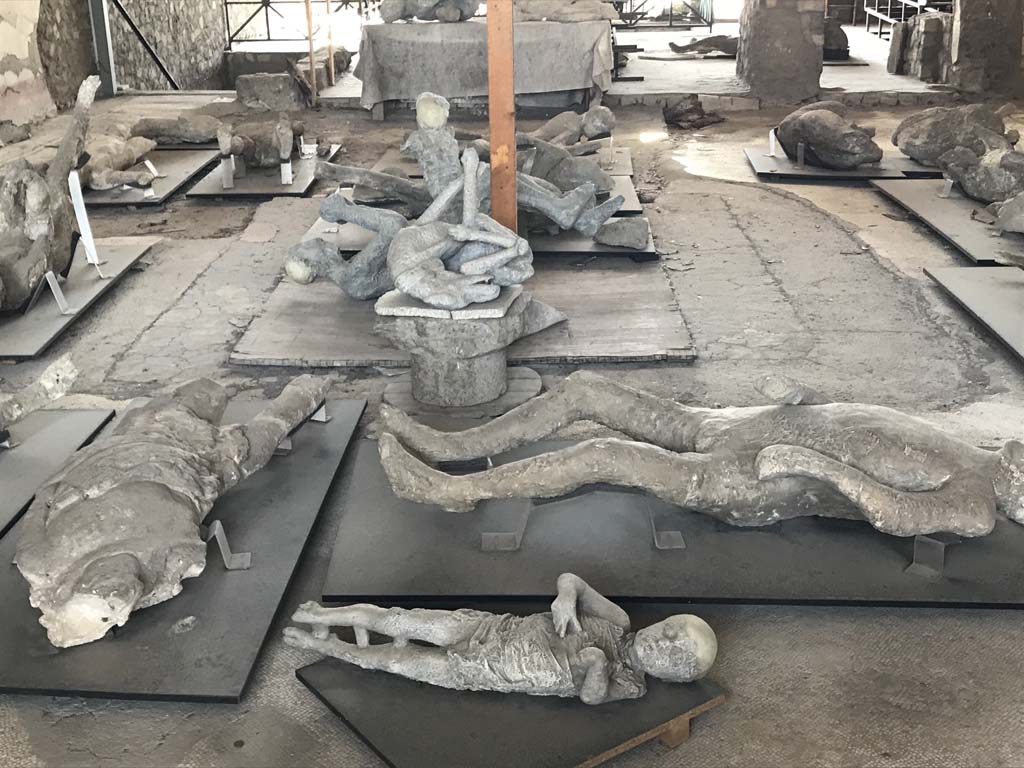
VI.17.42 Pompeii. April 2019. Looking west across atrium,
with detail of plaster-casts. Photo
courtesy of Rick Bauer.
The area was used to prepare the body casts for an exhibition.
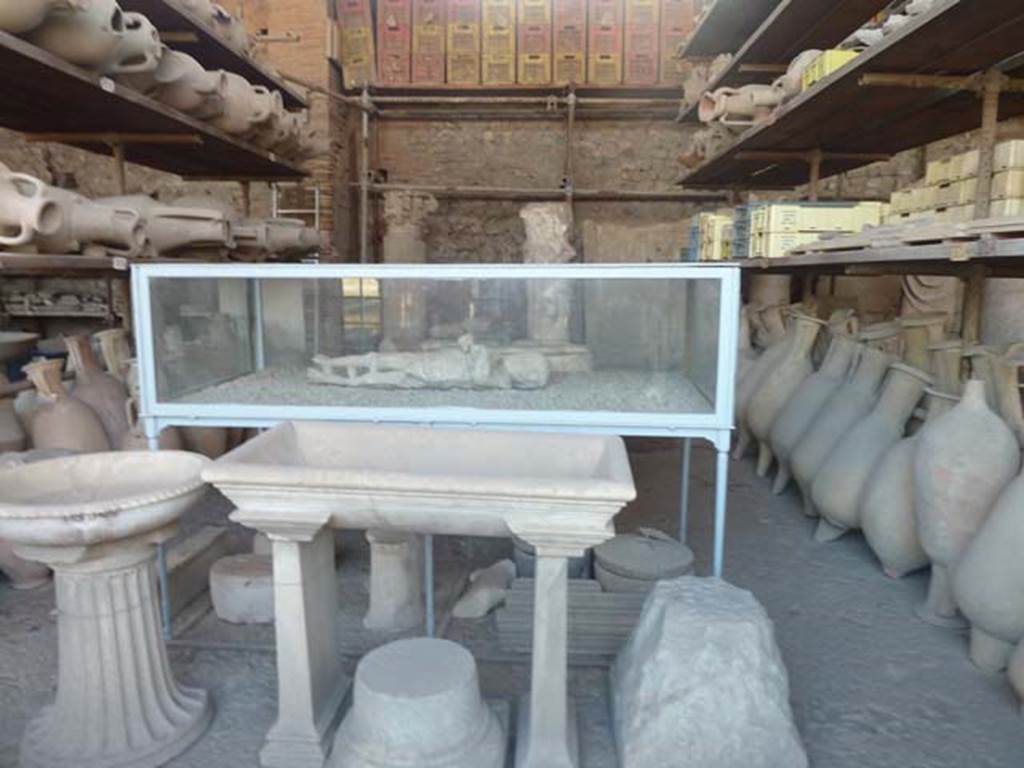
VII.7.29 Pompeii. September 2015. Items in storage, with the plaster cast of the child victim 53 from VI.17.42 in the display cabinet.
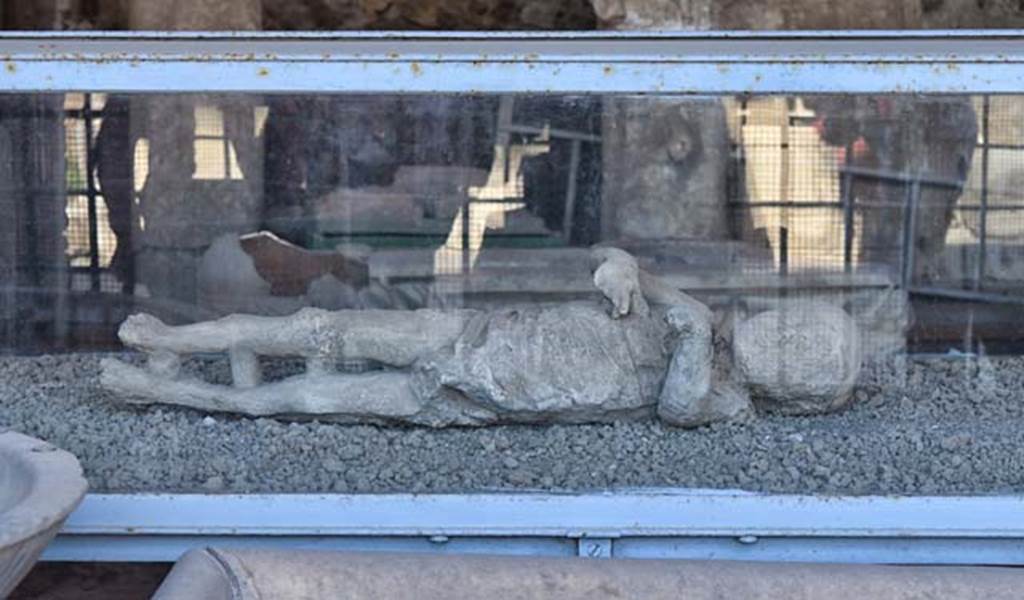
VII.7.29 Pompeii. Victim 53. April 2018.
Plaster cast of a child found in a corridor of a lower level of the House of the Golden Bracelet, VI.17.42.
Photo courtesy of Ian Lycett-King. Use is subject to Creative
Commons Attribution-NonCommercial License v.4 International.
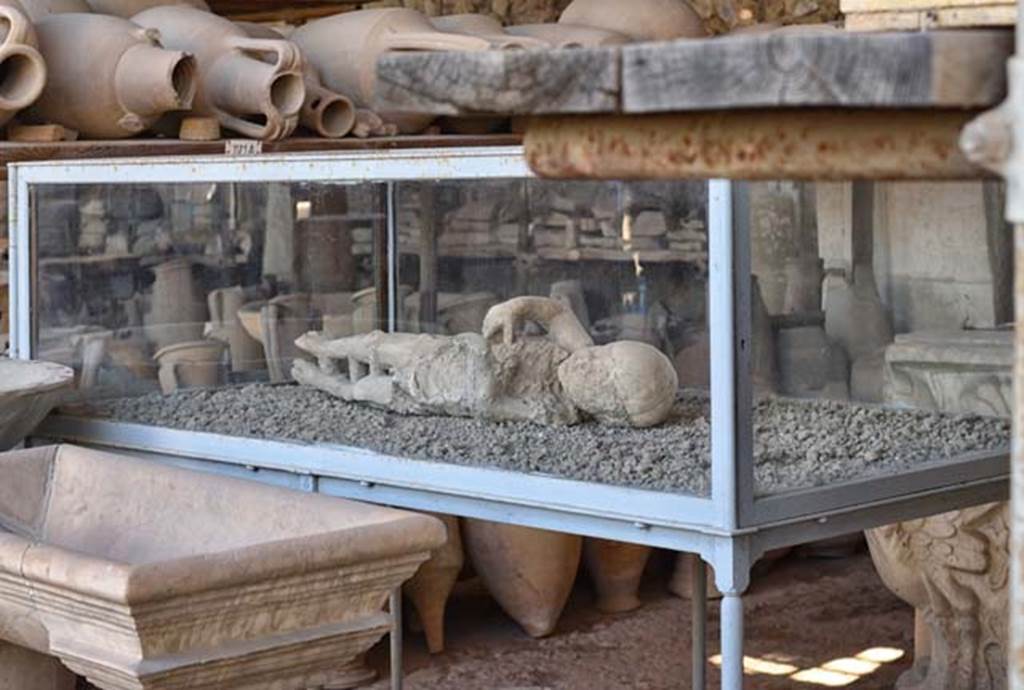
VII.7.29 Pompeii. April 2018. Items on display, as well as plaster-cast in display case of child found in VI.17.42.
Photo courtesy of Ian Lycett-King. Use is subject to Creative
Commons Attribution-NonCommercial License v.4 International.
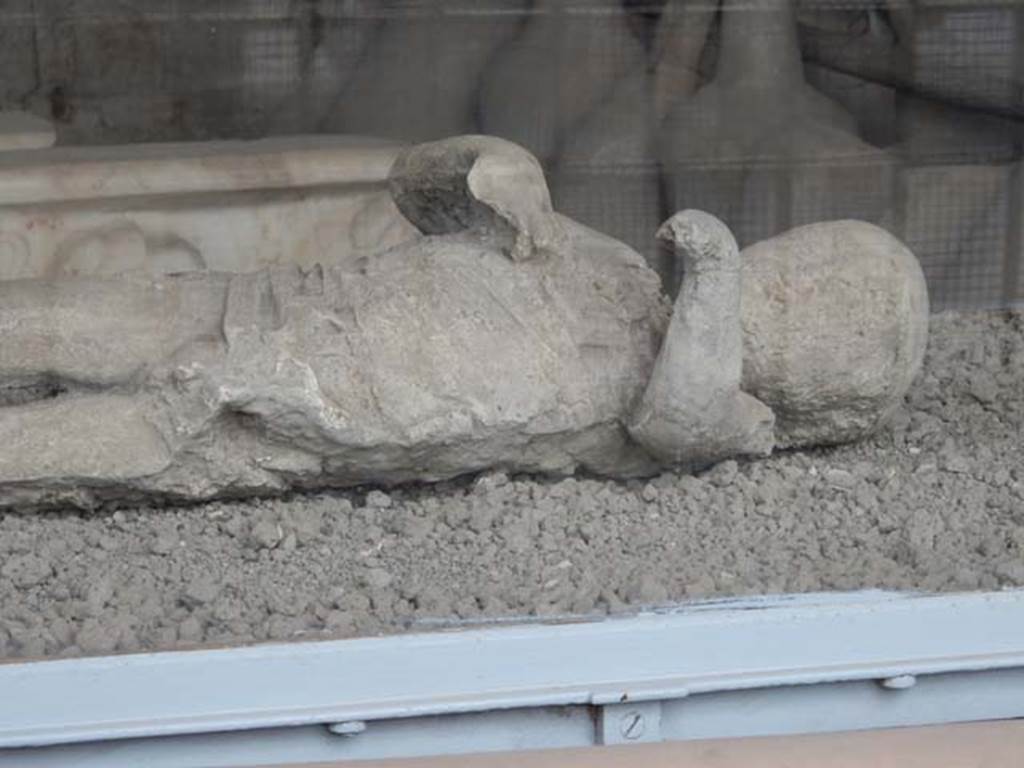
VII.7.29 Pompeii. Victim 53. May 2015.
Detail of plaster cast of a child found in lower corridor of VI.17.42. Photo courtesy of Buzz Ferebee.
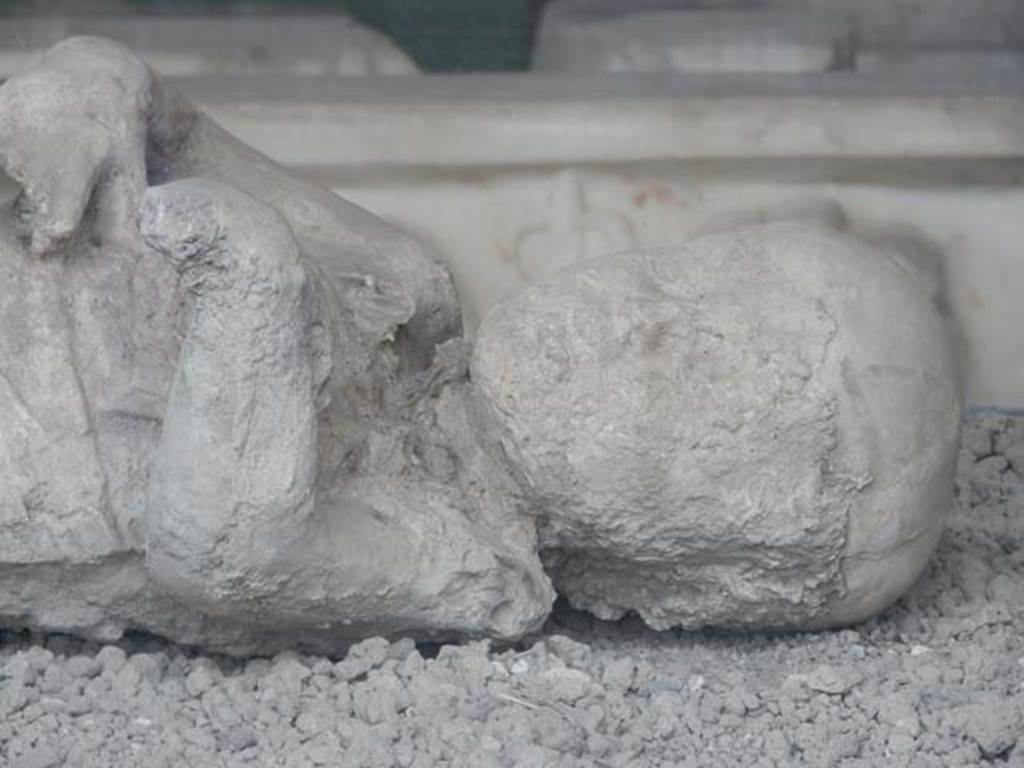
VII.7.29 Pompeii. Victim 53. May 2015. Detail of head of child found in VI.17.42. Photo courtesy of Buzz Ferebee.
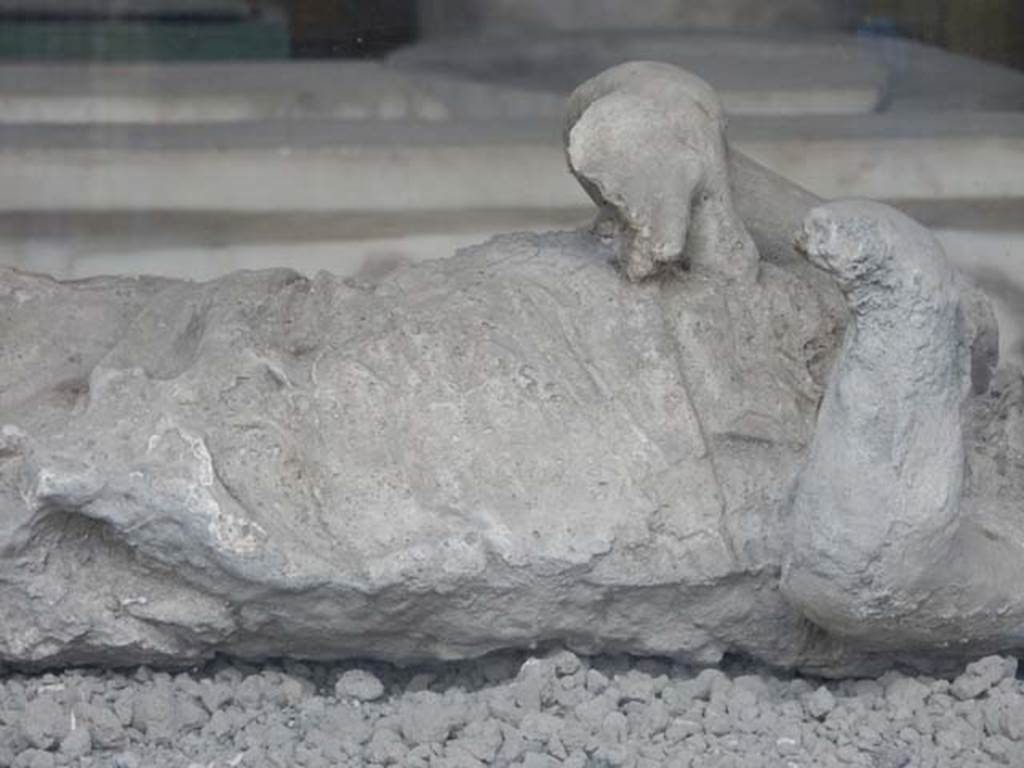
VII.7.29 Pompeii. Victim 53. May 2015. Detail from plaster cast of body of child found in VI.17.42. Photo courtesy of Buzz Ferebee.